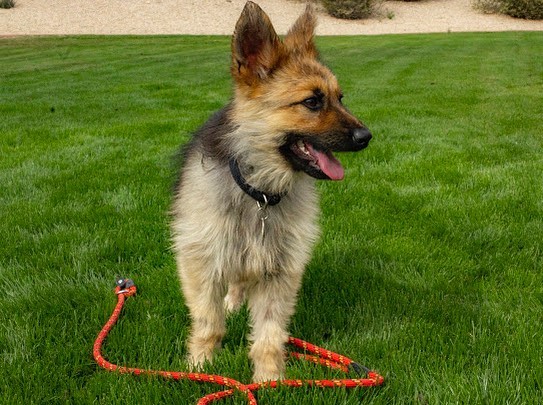Can German Shepherds have dwarfism? This intriguing question captures the attention of many German Shepherd enthusiasts and dog lovers alike.
German Shepherds can experience dwarfism, with pituitary dwarfism being the most prevalent form. This genetic disorder, characterized by inadequate growth hormone production, leads to stunted growth in the breed. Consequently, affected dogs often face numerous health challenges and typically have a reduced life expectancy.
In this blog, we’ll explore the rare but real phenomenon of dwarfism in German Shepherds, delving into its causes, symptoms, and the impact it has on the lives of these dogs and their owners.
Join us as we unravel the mysteries of this unique genetic condition and its presence in one of the world’s most beloved dog breeds.


Can German Shepherds Have Dwarfism?
When I first heard the term “miniature German Shepherd,” I instinctively pictured a smaller version of a purebred German Shepherd. I wondered if you could buy a German Shepherd, which stayed as cute as a puppy – forever.
German Shepherds can have dwarfism. However, they likely suffer from pituitary dwarfism, a rare genetic condition. A small healthy GSD is a mini German Shepherd, but this is a mixed breed whereby a GSD is crossed with a smaller dog such as a Poodle or Corgi.
I can see why it can get confusing. However, this article is solely about the dwarf German Shepherd, and I have to warn you what you will learn may break your heart.
Nonetheless, take a look at this inspiring dwarf German Shepherd named “Ranger,” who refuses to let dwarfism get in the way of living life to the fullest. He was born in Phoenix, Arizona, and is known as the dog that will “forever be a puppy.”

Despite his health battles and challenges early in life, Ranger lives happily alongside his family and doesn’t let anything get him down.
Watch Ranger In This Video…
German Shepherd Dwarfism
Pituitary dwarfism in dogs is an autosomal recessive inherited disorder that affects the function of the pituitary gland. It occurs primarily in the German Shepherd breed and its relatives, for example, the Saarloos Wolfdog and the Czechoslovakian Wolfdog.
So what exactly is the pituitary gland? This is a pea-sized endocrine gland found at the base of the brain and plays a significant role in regulating vital body functions and general well-being.
It is known as the “master gland,” as the hormones it produces are responsible for many different processes in the body, for example, growth, reproduction, metabolism, blood pressure, and controlling blood sugar levels.
Both the affected dog’s parents have to be carriers of the faulty gene, and it is estimated that 20% of German Shepherds now carry the defective gene:
With a recessive gene, when two carriers are mated, 50% of their offspring will be carriers, and 25% of their offspring will be dwarfs.
Pituitary dwarfism associated with growth hormone deficiency in German Shepherd dogs has been seen for decades, and dwarfs are born worldwide.
However, the condition has been reported to have recently spread quite rapidly in Europe, and this is for two reasons:
- Through the breeding of unsuspected carriers. The problem is that German Shepherds that are carriers of the recessive gene do not have any visible symptoms, so the reputable breeder would be none the wiser.
- Unscrupulous breeders realized they could sell a small German Shepherd more expensively if they tried to pass it off as a smaller version of a purebred. This is also the main reason for the confusion between a German Shepherd suffering from dwarfism and the miniature German Shepherd crossbreed.
Other Causes of Pituitary Dwarfism
We have learned that pituitary dwarfism in dogs is caused by the lack of growth hormone produced by the pituitary gland due to a genetic disorder. But what else can cause dog dwarfism?
- Tumor
- Cysts
- Infection
These other causes are also due to the lack of growth hormone produced by the pituitary gland.
Exploring the Prevalence of GSD Dwarfism
Dwarfism is common in German Shepherds 2 to 6 months old when symptoms of slow growth will be evident. No studies have confirmed the actual percentage of dwarf German Shepherds.
However, the breed is prone, and 20% of German Shepherds will be carriers of the faulty gene.
Pituitary dwarfism in German Shepherds must be taken very seriously when breeding as this is an incurable incapacitating disease that we could easily prevent.
As long as mating between two mutated gene carriers is stopped, no dwarf German Shepherds will be born.
The only way to prevent this disorder is by a diagnostic DNA test, as scientists have already identified the mutated gene as LHX3.
This diagnostic DNA test is available following 15 years of intensive research by The Companion Animals Genetics Expertise Centre of Utrecht University. It is one of the few tests available for genetic conditions.
If this DNA test were mandatory for all German Shepherd breeding and the implementation of a correct breeding policy, then pituitary dwarfism would be completely eradicated.
Unfortunately, screening all potential German Shepherd breeding is impracticable and seldom happens.
You could also argue that screening is unnecessary due to the low prevalence of the disease, even though we have the statistics for the number of carriers.
This is, of course, subjective, especially as we don’t know how many affected dogs die while in the womb or shortly after birth.
However, it is suspected that 90% of all pituitary dwarfism-affected dogs won’t survive, which would explain why dwarf dogs are rarely seen.
Some of the ones that survive are often sold, sometimes before the condition is recognized.
There is also the cruel breeding practice whereby unscrupulous breeders operating puppy farms (often called puppy mills) care more about profits than puppies.
These breeders don’t care if their unethical techniques lead to the inevitable suffering of dogs.
I found this sad little story of a rescued puppy from a commercial breeding facility in Indiana, where a German Shepherd puppy was suffering from dwarfism. It’s just heartbreaking.
If you are considering getting a German Shepherd Dog, make sure you read my complete buyer’s guide, How to Buy a German Shepherd.
Spotting the Signs of Dwarfism
Signs of a German Shepherd suffering from dwarfism are their slow growth rate, which usually becomes evident in puppies between 8-16 weeks old.
They will keep their puppy coat for longer in their first year until they eventually go bald. The head and lower legs usually remain with fur.
The dog’s features are in proportion, and they do not display shortened, deformed legs as in achondroplasia dwarfism, which is a different condition.
Dwarf puppies will retain their puppy coat for much longer than healthier littermates. However, they will lose the coat in their first year as the dog suffers from alopecia and will become bald, except for the head and lower legs.
Pituitary dwarfism in German Shepherds is a severe illness, and clinical signs are not limited to physical appearance. There are also many other hidden problems that a dwarf German Shepherd may suffer. These are some of the severe symptoms:
- Bacterial skin infections.
- Renal failure due to underdeveloped liver and kidneys.
- Cardiovascular problems.
- Breathing difficulties.
- Slow and dull intelligence to an underactive thyroid gland.
- Undescended testes in male dogs.
- Small testes and penis in male dogs.
- Irregular or absent heat cycles in females.
- Neurological symptoms due to abnormal cervical vertebrae.
- Secondary Hypothyroidism (underactive thyroid gland).
- Delayed dental eruption.
- Puppies often have a shrill bark.
- It may have the appearance of a fox.
How Long Do Dwarf German Shepherds Live?
According to the University of Utrecht, without proper treatment, the long-term survival rate of German Shepherds with dwarfism is poor, and many will not live to more than 3 to 4 years of age.
However, some dogs do live longer, probably because, in some cases, the pituitary gland still produces a minimal amount of hormones.
Although your German Shepherd may be displaying obvious visible signs of dwarfism, the diagnosis of pituitary dwarfism in dogs is via endocrine tests (blood and urine). Imaging tests may also be conducted to check for cysts.
Treatment
New methods of treating dwarfs have also become available in the last few years, mostly involving replenishing the missing hormones. There is no canine growth hormone, but these are some other options available:
- Porcine (pig) growth hormone. This is expensive, and the results differ.
- Progestins. These are steroidal drugs that stimulate the production of growth hormones.
- Thyroid hormones, e.g., synthetic levothyroxine, have been found to have some success. However, results vary.
Although treatment can significantly improve a dog’s life, it can also cause bothersome side effects. Sadly, there is no treatment to cure them.
Are Mini and Dwarf German Shepherds The Same?
Dwarf German Shepherds exist due to genetic disorders, while mini German Shepherds don’t actually exist. They’re cross-bred for aesthetic purposes.
However, if your German Shepherd looks small, it’s essential to crosscheck with various signs of dwarfism.
A dwarf German Shepherd needs the vet’s intervention to check for medical treatment.
On the other hand, miniature German Shepherds are cross-bred with other small breeds like Daschund, Border Collie, Corgi, and Poodle. As a result, the latter doesn’t need medical intervention.
Note: Be cautious about potential impacts when different breeds are allowed to breed for aesthetic reasons.
FAQs
How is dwarfism inherited in German Shepherds?
When it comes to dwarfism in German Shepherds, it is typically an inherited condition. This means that the condition is passed down genetically from the parents to their offspring.
The specific mode of inheritance for this condition can vary, but it is typically recessive, meaning that both parents must carry the gene for their offspring to inherit the condition.
It is important to work with a reputable breeder who conducts genetic testing to reduce the risk of inherited health conditions in their puppies.
How can breeders prevent dwarfism in German Shepherds?
If you’re a German Shepherd breeder looking to prevent dwarfism, there are a few key steps you can take. First, ensure only breed dogs that meet the breed standards for size and proportion. Regular health screenings can also help identify any potential genetic issues before breeding.
Additionally, it’s important to avoid inbreeding, as this can increase the risk of passing on harmful genetic traits. Working with a reputable breeder who prioritizes the health and well-being of their dogs can help ensure a successful breeding program.
Final Thoughts
Suppose you came here looking for a miniature German Shepherd, and this article has melted your heart. In that case, you can contact The Saartje Foundation in the Netherlands to help adopt and rehome a dwarf German Shepherd.
Please be aware that it will involve a potentially very high cost because the dog has particular health needs.
You can also contact them confidentially if you have a dwarf dog you feel you cannot keep, as the foundation has a small number of experienced people in various countries willing to give a dwarf a new home.
Related Posts You May Like:







